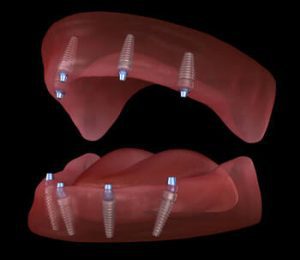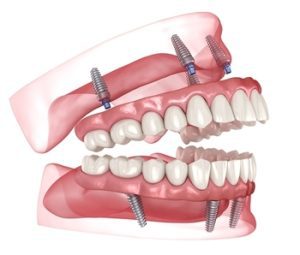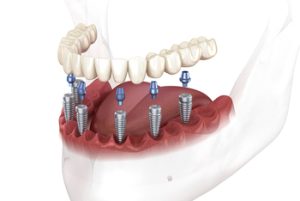In dental care, full mouth dental implants represent a significant advancement, providing a comprehensive solution for those grappling with missing teeth. However, the decision to undergo dental implant surgery isn’t made lightly, particularly considering the associated costs.
In this detailed guide, we’ll delve into the nuances of the cost for full mouth dental implants, shedding light on the factors influencing pricing, the procedure itself, and what to expect in terms of post-implant care. So, let’s bypass the expense and uncover the keys to attaining a celebrity smile affordably!
Understanding Dental Implants: The Cornerstone of Modern Dentistry
In the landscape of modern dentistry, dental implants stand as a cornerstone, revolutionising the way we address tooth loss. Understanding the fundamentals of dental implants is paramount before delving into considerations of cost and procedure intricacies.
1. What Are Dental Implants?
Dental implants represent a groundbreaking solution for replacing missing teeth. Composed of titanium posts, they serve as artificial tooth roots, meticulously inserted into the jawbone beneath the gum line. This integration with the jawbone provides a stable foundation for replacement teeth, ensuring durability and functionality akin to natural teeth.
2. The Anatomy of Dental Implants
- Implant Fixture: The titanium post, known as the implant fixture, serves as the root of the artificial tooth. This component is surgically positioned within the jawbone, where it fuses over time through a process called osseointegration.
- Abutment: Positioned atop the implant fixture, the abutment serves as a connector between the implant and the replacement tooth. It protrudes through the gum line, providing access for attaching the prosthetic tooth or teeth.
- Prosthetic Tooth: The prosthetic tooth, whether a crown, bridge, or denture, is custom-designed to match the shape, size, and colour of the patient’s natural teeth. It is securely affixed to the abutment, completing the restoration and restoring both function and aesthetics.
3. Functionality and Aesthetic Appeal
Dental implants not only restore the functionality compromised by missing teeth but also replicate the natural appearance of a complete smile. With implants, patients can confidently chew, speak, and smile, without the limitations or insecurities often associated with traditional tooth replacement options.
4. Advantages of Dental Implants
- Durability: Dental implants boast exceptional durability, with the potential to last a lifetime with proper care. Unlike traditional dentures or bridges, which may require periodic adjustment or replacement, implants offer a long-term solution.
- Bone Preservation: The integration of dental implants with the jawbone helps preserve bone density and prevent deterioration, a common consequence of tooth loss. This contributes to facial structure preservation and overall oral health.
- Natural Look and Feel: Dental implants closely mimic the look, feel, and function of natural teeth, providing a seamless integration into the patient’s smile. The custom-designed prosthetic teeth blend harmoniously with existing dentition, enhancing aesthetics and self-confidence.
5. Candidacy for Dental Implants
While dental implants offer numerous benefits, not everyone is an ideal candidate for this restorative option. Factors such as overall health, oral health, and the condition of the jawbone must be carefully evaluated by a qualified dental professional to determine suitability for implant surgery.
In essence, dental implants represent a remarkable innovation in restorative dentistry, offering a permanent solution for tooth loss that prioritises both functionality and aesthetics.
Understanding the intricacies of dental implants lays the groundwork for informed decision-making regarding tooth replacement options, paving the way for a confident and enduring smile.
The Cost for Full Mouth Dental Implants: Unravelling the Financial Considerations
As one contemplates the investment in full mouth dental implants, it becomes evident that the associated costs fluctuate significantly, dictated by a myriad of factors that warrant careful examination. Let’s dissect each component to grasp the nuances of dental implant pricing:
Number of Missing Teeth: Assessing the Extent of Restoration
The extent of tooth loss plays a pivotal role in determining the overall cost of full mouth dental implants. Understandably, the more teeth requiring replacement, the greater the investment required.
Full mouth dental implants typically entail the restoration of an entire arch of teeth, necessitating a comprehensive approach that may command a higher financial commitment compared to isolated tooth replacements.
Quality of Materials: Striking a Balance Between Durability and Aesthetics
Central to the cost consideration is the quality of materials utilised in the dental implant procedure. Opting for high-quality materials, albeit accompanied by a higher upfront cost, often translates to enhanced longevity and aesthetic appeal.
Whether titanium dental implants or custom-crafted prosthetic teeth, prioritising superior materials lays the groundwork for enduring satisfaction and value.
Expertise of the Dental Professional: Investing in Skill and Precision
The expertise of the dental professional overseeing the implant procedure is a critical determinant of both cost and outcome. While seasoned practitioners may command higher fees for their services, their proficiency and mastery of implant dentistry contribute to successful outcomes and mitigate the risk of complications.
Prioritising the skill and experience of the dental team is an investment in peace of mind and optimal results.
Additional Procedures: Addressing Complexities and Augmenting Success

From bone grafting to enhance the jawbone’s capacity to support implants to sinus lifts to accommodate implant placement in the upper jaw, these adjunctive procedures incur additional costs but are integral to ensuring long-term success and functionality.
Geographical Location: Navigating Regional Disparities in Cost
It’s imperative to acknowledge the influence of geographical location on the cost of dental implants. Urban areas or regions characterised by a higher cost of living typically exhibit elevated dental implant costs, reflecting the associated overhead expenses borne by dental practices.
Conversely, regions with a lower cost of living may offer more competitive pricing, presenting opportunities for cost-conscious patients to explore.
A Strategic Investment in Oral Health and Well-being
In conclusion, while the cost for full mouth dental implants may appear daunting, it’s essential to view it through the lens of strategic investment in oral health and well-being. By dissecting the factors influencing pricing and understanding the value proposition offered by dental implants—durability, functionality, and aesthetics—patients can make informed decisions that align with their needs and priorities.
Partnering with an experienced dental professional and prioritising the use of high-quality materials ensures a pathway to a confident smile that transcends mere restoration—it embodies lasting confidence and vitality.
Exploring Alternatives to Full Mouth Dental Implants: Tailoring Tooth Replacement Options
While full mouth dental implants offer a comprehensive solution for replacing missing teeth, alternative treatment options exist, catering to diverse patient needs and preferences. Let’s delve into these alternatives, focusing on traditional dentures, bridges, and implant-supported dentures, to provide a comprehensive understanding of available options:
1. Traditional Dentures: Restoring Functionality with Removable Prosthetics
Traditional dentures have long been a staple in tooth replacement, offering a removable prosthetic solution for patients missing multiple teeth or entire arches. Crafted from durable acrylic or resin materials, dentures are custom-fitted to the patient’s oral anatomy, providing restoration of chewing function, speech clarity, and aesthetics.
While traditional dentures offer affordability and accessibility, they may pose challenges such as reduced stability, the potential for discomfort, and the need for periodic adjustments due to changes in jawbone structure over time.
2. Dental Bridges: Bridging the Gap with Fixed Prosthetics
Dental bridges serve as an alternative to full mouth dental implants, particularly for patients seeking a fixed prosthetic solution to replace missing teeth. Comprising one or more artificial teeth (pontics) supported by adjacent natural teeth or dental implants, bridges are cemented into place, effectively bridging the gap created by missing teeth.
Dental bridges offer advantages such as enhanced stability, improved chewing efficiency, and preservation of adjacent tooth structure. However, they require the alteration of healthy adjacent teeth to accommodate the bridge, and longevity may be influenced by the health of supporting teeth and gums.
3. Implant-Supported Dentures: Combining Stability with Implant Technology
For patients seeking the stability and durability of dental implants with the affordability of traditional dentures, implant-supported dentures present a compelling alternative. Unlike traditional dentures, which rely solely on suction or adhesives for retention, implant-supported dentures are anchored securely to dental implants surgically placed within the jaw bone.
This innovative approach offers enhanced stability, improved chewing function, and reduced risk of slippage or discomfort associated with removable dentures. Implant-supported dentures can be either fixed or removable, providing flexibility and customisation to suit individual patient preferences.
Considering Patient Preferences and Treatment Goals
When exploring alternatives to full mouth dental implants, patients should consider factors such as lifestyle, budgetary constraints, oral health status, and treatment goals. While dental implants offer unparalleled stability and longevity, traditional dentures, bridges, and implant-supported dentures provide viable options tailored to diverse patient needs.
Consulting with a qualified dental professional is paramount to assess candidacy for each treatment option, weigh the benefits and limitations, and make an informed decision that aligns with the patient’s preferences and expectations.
Tailoring Treatment to Individual Needs
In conclusion, the array of alternatives to full mouth dental implants underscores the importance of personalised treatment planning and patient-centred care.
Whether opting for traditional dentures, dental bridges, or implant-supported dentures, patients can achieve restored functionality, aesthetics, and confidence in their smiles.
By collaborating closely with their dental care team, patients can explore alternative options, navigate treatment decisions, and embark on a journey towards optimal oral health and well-being tailored to their unique needs and preferences.
Understanding the Procedure: Navigating the Journey to a Restored Smile
The dental implant procedure is a meticulously orchestrated process, encompassing several stages that culminate in the transformation of a smile marred by missing teeth into one that exudes confidence and functionality. Let’s embark on a detailed exploration of each stage:
Consultation and Treatment Planning: A Foundation of Personalised Care
During the preliminary phase, the patient’s journey begins with a comprehensive consultation with their dentist. This pivotal step serves as a foundation for personalised care, where the dental professional evaluates the patient’s oral health, discusses their treatment goals, and explores suitable options for dental implant surgery.
Through open communication and collaboration, a bespoke treatment plan is crafted, taking into account the patient’s unique anatomical considerations, aesthetic preferences, and budgetary constraints.
Dental Implant Placement: Precision and Expertise in Action

This stage lays the groundwork for osseointegration, the biological process where the implants fuse with the surrounding bone, ensuring stability and longevity.
Attachment of Replacement Teeth: Crafting a Seamless Smile
As the implants gradually integrate with the jawbone over a period of months, the stage is set for the attachment of replacement teeth—a transformative moment in the dental implant journey. Once osseointegration is deemed successful, abutments—small connectors—are affixed to the implants, protruding through the gum line.
These abutments serve as anchorage points for custom-made replacement teeth, meticulously crafted to blend seamlessly with the patient’s natural dentition.
Whether crowns, bridges, or dentures, these prosthetic teeth are tailored to restore both function and aesthetics, ensuring a smile that looks, feels, and functions like natural teeth.
Post-Implant Care and Maintenance: Nurturing the Investment in Oral Health
With the completion of dental implant surgery, the patient embarks on a journey of post-implant care and maintenance—an essential component of preserving the investment in oral health.
Beyond the surgical suite, proper oral hygiene practices become paramount, with patients diligently following their dentist’s instructions for brushing, flossing, and attending regular dental check-ups.
Moreover, adopting a healthy lifestyle, free from habits such as smoking, contributes to the overall health and longevity of the implants and surrounding tissues, safeguarding the enduring success of the dental implant journey.
Embracing the Promise of a Renewed Smile
In essence, the dental implant procedure transcends mere restoration—it embodies the promise of a renewed smile, imbued with confidence, functionality, and longevity.
By understanding the intricacies of each stage—from consultation and treatment planning to implant placement and post-implant care—patients can embark on this transformative journey with clarity and assurance, guided by the expertise of their dental care team.
As the final pieces of the puzzle fall into place, a radiant smile emerges, a testament to the power of modern dentistry to restore not just teeth but self-assurance and quality of life.
The Evolution of Dental Technology in Implant Dentistry: Enhancing Precision and Patient Care
In recent years, the integration of cutting-edge dental technology has revolutionised the field of implant dentistry, ushering in an era of unprecedented precision, efficiency, and patient satisfaction. Let’s delve into the latest advancements in dental technology and their transformative impact on implant dentistry:
1. Cone Beam Computed Tomography (CBCT): A Three-Dimensional Perspective
Cone Beam Computed Tomography (CBCT) has emerged as a game-changer in implant dentistry, providing clinicians with detailed three-dimensional images of the oral and maxillofacial structures. Unlike traditional two-dimensional dental radiography, CBCT offers enhanced visualisation of bone morphology, nerve pathways, and anatomical landmarks, facilitating precise treatment planning and implant placement.
With CBCT technology, dental professionals can assess bone density, identify potential complications, and develop customised implant placement strategies tailored to each patient’s unique anatomical characteristics.
By following these digitally planned trajectories, clinicians can achieve precise implant placement with minimal trauma to surrounding tissues, reducing surgical time, postoperative discomfort, and complications. Guided implant surgery enhances treatment outcomes, accelerates healing, and improves patient satisfaction.
Insurance Coverage for Dental Implants: Navigating Financial Assistance for Oral Health
Understanding dental insurance coverage for dental implants is essential for patients considering this transformative treatment option. While dental insurance plans vary in their coverage of implant procedures, navigating policies to maximise benefits can significantly alleviate the financial burden.
Let’s delve into the intricacies of dental insurance coverage for dental implants and strategies for optimising insurance benefits:
1. Assessing Dental Insurance Policies: Understanding Coverage Limitations
Before embarking on dental implant treatment, patients should thoroughly review their dental insurance policies to ascertain the extent of coverage for implant procedures. While some insurance plans offer partial coverage for implants, others may provide no coverage at all, categorising implants as elective or cosmetic procedures.
Familiarising yourself with coverage limitations and exclusions is crucial for managing expectations and planning accordingly.
2. Exploring Supplemental Dental Insurance Options: Bridging Coverage Gaps
In instances where dental insurance coverage for dental implants is limited or nonexistent, exploring supplemental dental insurance options can offer a viable solution.
Supplemental insurance plans tailored to dental implants may provide enhanced coverage for implant procedures, filling in coverage gaps and mitigating out-of-pocket expenses.
Patients should inquire about supplemental insurance options with their dental insurance provider or seek advice from insurance brokers in dental coverage.
3. Pre Authorisation and Documentation: Advocating for Coverage
To optimise insurance benefits for dental implants, patients should proactively engage with their dental insurance providers and seek pre-authorisation for the planned treatment.
Providing comprehensive documentation, including treatment plans, diagnostic images, and rationale for implant placement, can strengthen the case for coverage approval.
Additionally, collaborating closely with the dental care team to ensure accurate coding and submission of claims enhances the likelihood of favourable coverage outcomes.
4. Flexible Spending Accounts (FSAs) and Health Savings Accounts (HSAs): Leveraging Tax-Advantaged Funds
Utilising tax-advantaged accounts such as Flexible Spending Accounts (FSAs) or Health Savings Accounts (HSAs) can provide additional financial flexibility for dental implant treatment.
Contributions to these accounts are made with pre-tax dollars, allowing patients to allocate funds towards out-of-pocket expenses associated with dental implants, including deductibles, copayments, and uncovered treatment costs.
Leveraging FSAs and HSAs can effectively reduce the out-of-pocket financial burden associated with dental implant procedures.
5. Financing Options and Payment Plans: Spreading Costs Over Time
For patients facing significant out-of-pocket expenses for dental implants, exploring financing options and payment plans can alleviate financial strain while still accessing essential dental care.
Many dental practices offer flexible financing arrangements, allowing patients to spread the costs of implant treatment over manageable instalments. Patients should inquire about available financing options and negotiate payment terms that align with their budgetary constraints.
Empowering Patients Through Financial Planning
In conclusion, navigating dental insurance coverage for dental implants requires proactive engagement, strategic planning, and advocacy.
By understanding coverage limitations, exploring supplemental insurance options, and leveraging tax-advantaged accounts, patients can optimise insurance benefits and minimise out-of-pocket expenses associated with dental implant treatment.
Empowering patients through financial planning not only facilitates access to transformative dental care but also enhances overall oral health and well-being.
Frequently Asked Questions
In this section, we address common inquiries and provide clarity on key aspects of dental implant surgery and post-procedural care.
1. How long do dental implants last?
Dental implants are designed to be a long-term solution for missing upper or lower teeth and can last a lifetime with proper care and maintenance.
2. Does dental insurance cover the cost of dental implants?
Dental insurance coverage for dental implants varies depending on the insurance provider and the patient’s specific policy. Some plans may cover a portion of the cost, while others may not cover dental implants at all.
3. Are dental implants suitable for everyone?
While dental implants are a popular choice for tooth replacement, not everyone is a suitable candidate. Factors such as overall health, oral health, and the condition of the jawbone play a role in determining candidacy for dental implant surgery.
Conclusion: Take the First Step Towards a Confident Smile

Don’t let concerns about cost deter you from exploring this transformative dental treatment. Reach out to us to discuss your options and develop a treatment plan tailored to your needs.
Remember, the sooner you take action, the sooner you can enjoy the benefits of a beautiful, functional smile. Take the first step today towards reclaiming your dental health and confidence.
Transform your smile into a Hollywood masterpiece! Dial (07) 3324 9172 to connect with Carindale Family Dentist and begin your journey to the dazzling smile of your dreams!
Note: Any surgical or invasive procedure carries risks. Before proceeding, you should seek a second opinion from an appropriately qualified health practitioner.
References:
https://www.fda.gov/medical-devices/dental-devices/dental-implants-what-you-should-know
https://www.aihw.gov.au/reports/dental-oral-health/oral-health-and-dental-care-in-australia/contents/private-health-insurance
https://canberradaily.com.au/exploring-the-advancements-in-dental-implant-technology/
https://www.mayoclinic.org/tests-procedures/dental-implant-surgery/about/pac-20384622
https://www.hopkinsmedicine.org/health/treatment-tests-and-therapies/dental-implants
https://www.healthline.com/health/dental-and-oral-health/benefits-of-dental-implants




